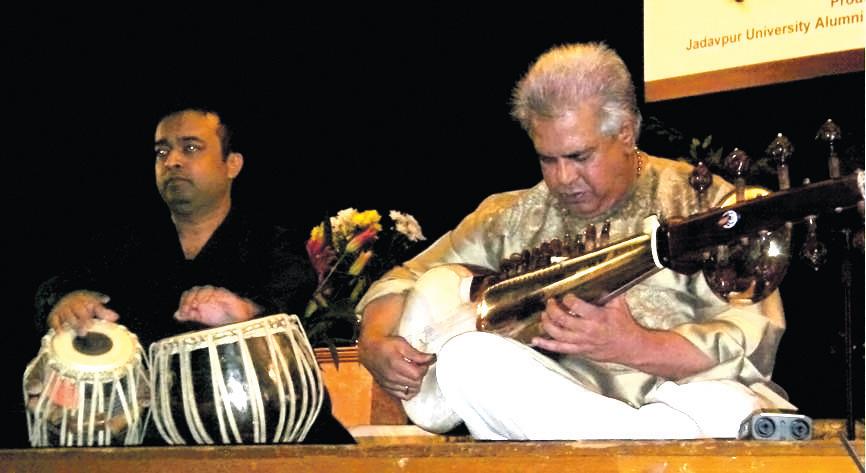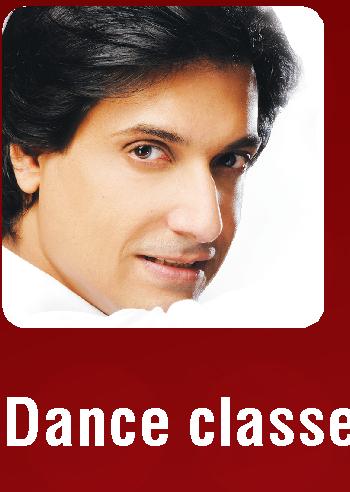
3 minute read
Bengali flavoured musical evening
from 2012-09 Sydney (1)
by Indian Link
The Jadhavpur University
Alumni Association (JUAA), in cooperation with the Bengali Association NSW, co-hosted an enjoyable feast of classical and light music on August 18, to the delight of a 200-strong audience.
Sri Avijit Sarkar and Smt Srijani Dan charmed the audience with several compositions in Bengali and Hindi, and surprised everyone with some rare old gems. Avijit was in his element when he rendered Ei Raat Aamaar Tomaar, a classic of yesteryears by Hemanta Kumar (Yeh nayan darey darey in Hindi). Srijani Dan was exceptional in her rendering of O Sajna barkha bahaar aayi and Lag jaa galey sung originally by Lata Mangeshkar. She was equally good in her Bengali rendering of Aami je jolsha ghorey
Avijit Sarkar regaled the audience by reciting the hits of Manna Dey and Hemanta Kumar such as, Ganga aaye kahaan se, Aey meri zohra jabeen tujhe maloom nahin, and Phool gendva na maaro, whilst Hemanta’s Na tum hamen jaano, na hum tumhe jaaney was lilting and conveyed the feelings of the lyrics well. The audience’s approval was signified by prolonged claps and ‘wah wahs’. Sadiq Rehmani on the guitar and Sri Avijit Dan on the tabla lived up to their youthful promise and ably accompanied the main artistes.
The second half of the evening was a pure Hindustani classical concert on the sarod by Sri Anindya Banerjee. As though his musical pedigree and tutelage from the late Ustad Ali Akbar Khan and the late Nikhil Banerjee on the sitar was not enough, his style of playing is that of the SeniaMaihar gharana that has given the musical world luminaries like Pandit Ravi Shankar and Pandit VG Jog. Anindya Banerjee introduced the origins of the instrument, explaining that the word, ‘sarod’ is a derivative of ‘Sarada’ the Goddess of learning, Saraswati with her divine veena He has worked on his instrument to play the ragas that can only be played on the veena, and has adapted these suitably. Sri Banerjee was accompanied on the tabla by Maharishi Rawal, who complimented exceedingly well this unique style of sarod playing. Sri Banerjee kicked off with an Alaap, Jod and Jhala in raga Kedar, an evening raga He played a Gat in Jhaptaal in the same raga towards the end. His sarod playing was skill of the deity as well as his mischievous qualities through lively and playful music and dance steps. steps characteristic of the mighty Hindu deity, their anklets jingled vigorously, echoing the “Jan-jana” tune of the song.
But it was dances like Jugalbandi and The Story of the Artisan that reeled the audience in and left them wanting more!
Jugalbandi presented the story of an intense battle between drought and flood. Graceful thrusts of the body and sharp crescendos in music kept the audience on the edge of their seat throughout the performance.
The Story of the Artisan was a particularly poignant item that depicted the story of a sculptor who relentlessly tries to create brilliant works of art, but keeps finding that her work lacks something essential. After perpetual disappointment, she eventually realizes that her sculptures will only gain depth if she literally pours her own soul into them. The protagonist of this item sparkled on stage, her facial expressions were incredibly evocative and her “sculptures” were equally impressive, moving with grace on stage.
Gopala enacted the story of Lord Krishna and his gopis. Like a scene frozen in time, this dance portrayed the beauty, charm and musical
But just when audiences thought that they had seen the very best of the show, Kalashree founder and guru herself, Dhanashree Karandikar, stepped onto the stage. Finishing her program with a bang, Dhanashree not only mesmerized audiences with her incredible poise and brilliant ability to easily switch between different emotions; she also illustrated the pure joy and passion for dance on which her school is built.
“The students should not learn Bharathanatyam as a strict art,” she said. “They should learn the technique, the discipline, the love and the enjoyment of it”.
Anusha Menon
inspired, although he found the faltering sound system provided to him a definite distraction. At one point Sri Banerjee chose to play without the hall microphones and still enthralled the audience by playing Raag Desh, Raag Malkauns and Raga Darbari Kaanada all of which held the audience to rapt attention. To conclude the evening, he played a dhun in Raga Bhairavi after the audience pleaded for more. The organisers acknowledged the courtesies extended by Taranaa and the Nataraj Music Academy.
Catering during the intermission was adequate, if not sumptuous. Over $1200 in funds was raised from the event. Part of the proceeds will go towards Mukti, an NGO that serves deprived communities and villages in the Sundarbans area of West Bengal. A contribution will also be made to the Bengali Association of NSW’s building fund. Wellknown musicians and local musical personalities performed at the fundraiser without a fee - a commendable gesture indeed.
Malli Iyer










